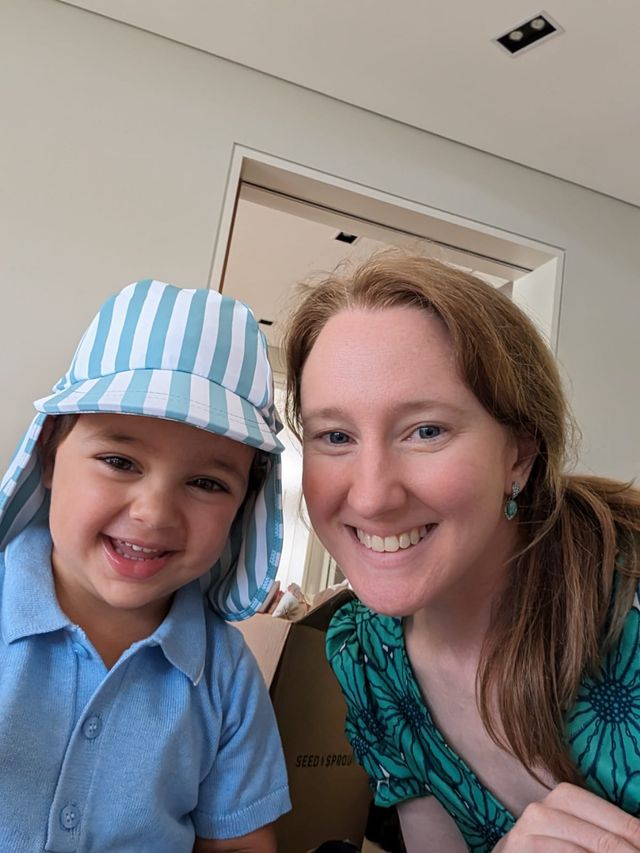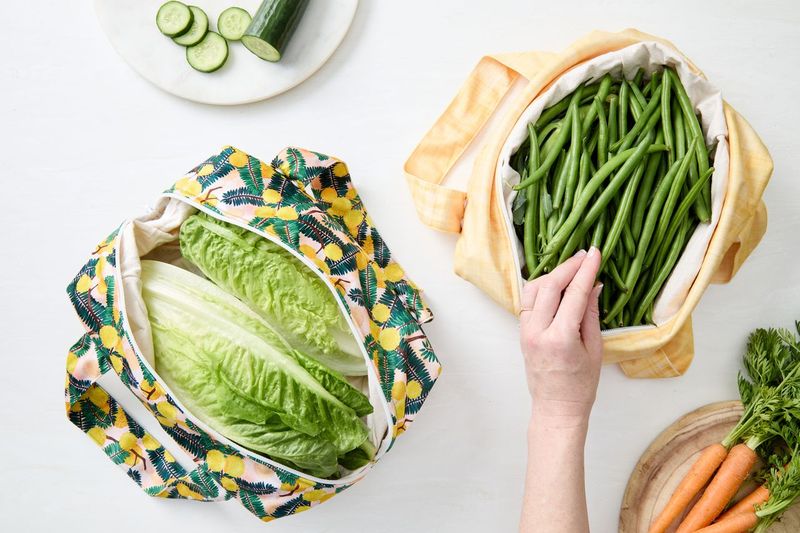Currently Empty: $0.00

Founder Story: The Forgotten Mint That Became a Six-Figure Business
Some founders start their journey with a business plan, a mentor, or a pitch deck. Fiona Raphael started hers with a forgotten bunch of mint, a Facebook DM, and a moment of pure, slightly obsessive curiosity that would eventually rewrite how Australian families store their food.
Before she ever cut fabric, trademarked a name, or imagined her product on shelves in five states, she found herself in a random message thread with a stranger online — the tiny spark that would turn a scrappy experiment into a national brand.
“For me that moment happened before I had started putting veggies into Pods, and I was still wondering whether anybody else had already tried it. I was hunting around Facebook groups and I DMed a lady who said she was going to try a PUL bag for food storage. I asked her how it went and she told me she’d put cheese in a PUL bag and the cheese had dried out. That was the lightbulb moment when I thought ‘This means moisture is escaping the bag!!!’”
Most people would have shrugged and continued scrolling. Fiona grabbed the thread, pulled it, and didn’t let go.
That single sentence — the cheese dried out — cracked open a realisation that the entire food-storage industry had overlooked. She tested it, proved it, and let that forgotten mint sit for week after week until it practically turned into her first investor pitch.
From Lawyer Brain to Founder Brain — and the Habit She Had to Unlearn

Fiona was a lawyer before she was a founder, and in the beginning that mindset showed up in ways that helped and hindered her.
“I’d like to think my analytical thinking skills played a role in the initial idea! My brain latched on to the realization that moisture escapes from a PUL bag, and I knew the significance of that because I had seen the condensation sitting on my rotten baby spinach leaves. It felt more like a discovery than a development process, because I immediately knew what I wanted to try, and when I tried it, it worked amazingly well.”
But she also knew what she needed to leave behind.
“The habit to unlearn was over-analysis. In business it’s mostly not helpful to consider every possible outcome before you act! It’s more a case of putting something out there, testing it, and refining over time.”
That shift — from paralysis to progress — became the heartbeat of Produce Pod’s early evolution.
The First Nine Months: Slow Burn Before the Wildfire
The business didn’t skyrocket immediately, and Fiona is refreshingly honest about that.
“In hindsight I think those first nine months were valuable because I was testing the market for the product, gathering reviews and gaining credibility. I could have pushed harder earlier, but honestly I had no idea what I was doing so taking it slow was the right approach! However if I had to go back and do it again, I would partner with some micro-influencers to build early awareness and nudge things forward a little.”
Those months were quiet. Then suddenly — not quiet.
A caravanning creator posted a shout-out, and the floodgates burst wide open.
“It was order fulfillment that broke first. I was fulfilling orders myself and I was in no way set up to pack and send hundreds of orders within a few days. To make things much worse, I had recently decided to create a packaging sleeve which I was folding, cutting and taping myself. It was an extremely time-consuming process. When we re-stocked a few months later, I was still doing the fulfillment myself. But with so much pent-up demand for the Pods, the re-stock was another similar experience and I quickly realised I needed to make some changes. I found a fulfillment partner which was an excellent decision.”
It’s the type of chaos only a founder can laugh about after the fact.
The Genius Inside the Pod — Explained Simply

The beauty of the Produce Pod is that it looks simple, but the science behind it solves a problem every household experiences without knowing how to articulate it.
“If you keep your veggies uncovered in the fridge or crisper, they dry out and wilt. If you keep them in a plastic bag, which most people do, condensation builds up and the veggies rot. The Produce Pod combats both these problems, and it’s amazing how long veggies can last if you can prevent both wilting and rotting. The damp cotton inner layer keeps the veggies hydrated which prevents wilting. The PUL outer layer lets condensation escape at a low rate which prevents rotting.”
It’s not magic. It’s engineering disguised as practicality.
The Wholesale Leap — and the Three Trenches She Had to Cross
When Fiona moved from DTC sales to wholesale, it required a mental and operational pivot that caught her by surprise.
“Wholesale was a real challenge, so much harder than ecommerce! I would say the three biggest hurdles were margins, packaging and how to find customers!”
Each hurdle had its own playbook.
“I quickly realised my margins were terrible and simply would not work for wholesale. I had to re-assess every cost: manufacturing, packaging, shipping and fulfillment. I also had to adjust my pricing.”
Packaging wasn’t just aesthetics — it was identity.
“Developing wholesale appropriate packaging was quite a process. I feel strongly about minimising packaging and avoiding plastic, so it had to strike a balance between sustainability and shelf appeal. I also wanted to let the Pods shine through and not be hidden! After a lot of trial and error, I landed on a recycled cardboard sleeve that clearly explains how the Pod works while giving customers a glimpse of the beautiful designs!”
And finding stockists? No easy hack.
“How to find wholesale customers was the most difficult hurdle. Honestly there is no easy way! I did a few trade shows and landed some customers that way. However I’m now finding that our meta ads are reaching retailers who contact me and become stockists. We are developing a really diverse range of stockists all over Australia and I love partnering with other small business.”
Why Regional Customers Were Always Going to Be Her Superfans
Fiona discovered that Produce Pods weren’t just useful — they were transformational for remote households.
“Regional households face higher food waste costs because produce has often travelled further before it even reaches the fridge. They also face longer travel times to get to the shop, which means they really want to shop less frequently. I’ve found that regional customers and caravanners account for a very large proportion of my customers! They find that with the Pods they can buy in bulk and it’s not only the money saving which is important to them, it’s the convenience as well.”
It’s cost-of-living relief in fabric form.
Growth Pains, Cash Flow Judgement, and the Courage to Spend Slowly
Scaling is messy — Fiona doesn’t sugarcoat it.
“The initial investment was significant because I had to pay for the patent application as well as the stock. Because of that I was very risk averse when it came to spending more money. I took the view that if the product was as great as I thought it was, it should gain traction via social media without paid advertising. Eventually that did happen! From there it was a case of starting very small with the outsourcing and building it up very slowly.”
Slow, steady, sustainable — the opposite of Silicon Valley growth theatre.
Food Waste: A National Crisis and a Personal Motivation

Her mission is crystal clear — because the numbers are staggering.
“The statistics on food waste are fairly horrifying. According to a 2023 report by The Australia Institute, not only does food waste cost the average household between $2,000 and $2,500 per year, but supermarkets actually profit from it! With the cost-of-living crisis, spoiled veggies is the last thing families want to spend their money on. Every week I hear from customers who tell me they’ve stopped throwing out produce and their grocery bills have dropped, and it honestly makes me so happy to hear!”
Those messages kept her going through the long nights and fulfilment marathons.
For Side-Hustlers Sitting on Their “Mint Moment”
Her advice is the antidote to perfection paralysis.
“I’m an advocate for getting your product out there as soon as possible and collecting feedback. Create a quick Shopify site and start selling to friends, family and colleagues! You’ll learn more from those first ten customers than from months of planning and refining. Don’t spend money on perfect packaging or professional photos. People care more about whether your product solves their problem. Once you’ve proven there’s interest, you can start improving the customer experience piece by piece.”
And just like that, a forgotten mint becomes a six-figure lesson in momentum.

